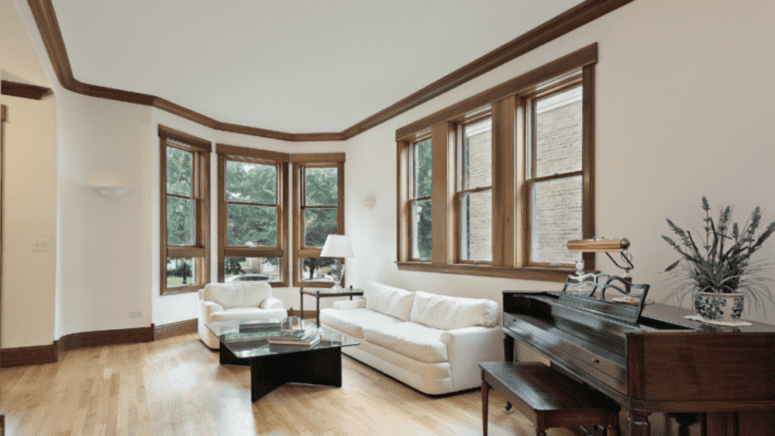How to Remove Paint from Wood Trim for a Classic Restoration
- Published on
- 7 min read
-
 Sam Dadofalza Associate EditorClose
Sam Dadofalza Associate EditorClose Sam Dadofalza Associate Editor
Sam Dadofalza Associate EditorSam Dadofalza is an associate editor at HomeLight, where she crafts insightful stories to guide homebuyers and sellers through the intricacies of real estate transactions. She has previously contributed to digital marketing firms and online business publications, honing her skills in creating engaging and informative content.
Older or historic homes are known for being loaded with character — and that often takes the form of ornate woodwork and trim. In addition to the obvious (baseboards, window frames, crown molding), that might also include built-in bookcases, fireplace mantels, and chair rails. But if the wood trim has been covered by paint, that can sometimes detract from its natural beauty and charm, so you’re maybe curious as to how to remove paint from wood trim.
Worth the trouble?
Before tackling this time-intensive task, take a closer look at the style, size, and quality of the trim. Craig Russell, founder and CEO of The English Contractor, a highly rated building company in Cincinnati, Ohio, typically paints trim when doing a historical restoration, where the wood trim is decorative and in good enough shape to be preserved.
If your trim is very unique or ornate and can’t be replicated with the new trim that’s available today, it may be worth the effort to strip and restore. On the other hand, if the trim is relatively simple and along the lines of what you could get off the shelf at your local home improvement store, it may make more sense — from both a time and cost standpoint — to rip and replace.
‘The right thing to do’
However, there are a few reasons why, despite the angst of removing paint, you might want it gone.
After years of wear, the paint may have started to fade or peel. Or perhaps you’re restoring an older home with unique custom millwork and want to return it to its classic state.
If you own a historic home, purists would argue that leaving the original wood is simply the right thing to do. Original materials can’t be replaced once they’re removed. The best approach is to strip the paint and preserve the wood. It takes time, effort, and money to do it safely and correctly, but it’s worth the investment, as it increases the overall visual appeal of the space.
While it may seem an overwhelming task, with some perseverance, expert tips, and the right tools, you can restore your wood trim to its original glory.
Step 1: Check for lead
If your home was built before 1978, the trim’s paint may contain lead, which can pose a myriad of health problems, particularly to young children. To prevent potential lead poisoning when stripping old paint, the EPA recommends testing the paint for lead.
While there are DIY lead testing kits available at your local hardware store or online, the EPA recommends having a certified lead-based paint inspector visit your home to conduct an in-person inspection.
Pro tip: To find an inspector near you, contact the National Lead Information Center.
Once you’ve verified that the paint you’d like to remove is lead-free, you can safely proceed.
Step 2: Gather the tools of the trade
Russell recommends having the following essentials on hand:
- Protective gear: gloves, goggles, and a mask
- Quality paint scraper
- Heat gun
- Chemical paint stripper
- Sandpaper
- Masking paper and masking tape
- Paint brushes to apply the stripper
- Sanding materials (either 80-grit sandpaper or an 80-grit foam block, which can be easier to grip when using for long periods of time)
- Rags
Step 3: Prepare the area
Next, you’ll need to set up the room where you’ll be stripping paint. Here’s what Matt Kunz, former president of Five Star Painting, a Neighborly company, recommends:
- Drape a chemical-resistant tarp or other type of protective cloth over the floor and furniture.
- Cover the areas surrounding the trim with thick masking paper, cardboard, or paper bags.
- Open all windows and maximize airflow by turning on any ceiling fans and making sure vents are open.
“Many modern-day paints [have low volatile organic compounds (VOCs)] but if you’re working to remove old paint, it’s likely high-VOC, in which case you’ll need to be more careful,” says Kunz.
Step 4: Apply paint stripper
If you’re using a chemical paint stripper to remove old or stubborn paint, safety is key. Make sure the room is well-ventilated, and wear gloves, eye protection, and a mask.
You can find non-toxic paint strippers on the market that aren’t as dangerous for the user or the environment. However, they tend to not be quite as effective, so they take longer to use and might involve some more elbow grease.
Apply the paint stripper as evenly as possible using a natural bristle brush. Avoid plastic bristles, as they will melt when they’re dipped into the paint stripper.
Cover the freshly applied paint stripper with a heavy-duty plastic trash bag, conforming the plastic to the trim so that the paint stripper is exposed to as little air as possible, recommends Bill Nishanian, owner of Nash Painting in Nashville. Leave the plastic in place for 15 to 20 minutes before removing it.
“Specific instructions will vary by manufacturer, so be sure to follow their guidelines,” says Kunz.
Pro tip: When you choose a paint stripper, stick to the same chemical. Kunz warns that mixing chemicals could cause issues or create a toxic hazard.
Step 5: Scrape off loose paint
The chemical stripper will cause the old paint to loosen and bubble up from the wood. When that happens, use your paint scraper to remove the loose paint. Depending on how many layers of paint have been applied and the intricacies of the wood trim, you may need to repeat this process several times.
Kunz recommends using a contour scraper, which works for a variety of different-sized areas. This way, you won’t need to switch between scrapers as you work.
With the scraping step, patience is key, especially if you’re trying to preserve wood trim in a historic home. The biggest mistake that Russell sees is people moving too fast and damaging the wood. “It’s easy to over-scrape or gouge the wood,” he says.
Step 6: Remove the remaining paint with heat
If stubborn paint remains after several cycles of stripping and scraping, you can try using a heat gun.
As Russell explains, a heat gun is like a high-powered hair dryer. Point it at the paint to heat it enough so that the paint bubbles up and loosens. Once the paint is bubbly, you can again use the scraper to remove it.
“With heat guns, you need to make sure that the temperature is hot enough to remove the paint, but not so hot that you end up scorching or burning it,” he says.
Step 7: Sand and wipe down the wood
Once the paint has been removed, use sandpaper to lightly sand down the surface. This will smooth out any uneven spots, which is especially important if you plan to apply stain to the newly paint-free wood. In that case, Kunz also recommends bleaching the wood in preparation for staining, as old paint can sometimes leave a stain or discoloration behind.
Next, wipe down the wood with a clean cloth, an especially important step if you plan to apply any stain to the trim.
Pro tip: In some cases, Russell says you may need to rub down the wood with a chemical neutralizer, mineral spirits, or water.
Successful paint removal starts with patience
Don’t get discouraged if the paint doesn’t come off in the first attempt. Stripping paint from wood trim isn’t quick and easy. It may require multiple rounds of stripping, waiting, and scraping.
But if you’re working with unique, ornate, or historic trim that can’t be replaced, it may be well worth the time and effort to remove the old paint and reveal the natural beauty that lies beneath. If you’re gearing up for future home improvement projects, it’s worth knowing your home’s current value. Get a quick, ballpark estimate in under two minutes with HomeLight’s Home Value Estimator.
Header Image Source: (pics721 / Shutterstock)






